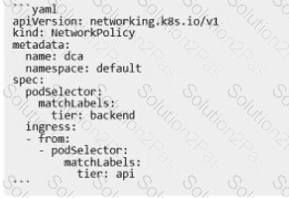DCA Docker Certified Associate (DCA) Exam Free Practice Exam Questions (2025 Updated)
Prepare effectively for your Docker DCA Docker Certified Associate (DCA) Exam certification with our extensive collection of free, high-quality practice questions. Each question is designed to mirror the actual exam format and objectives, complete with comprehensive answers and detailed explanations. Our materials are regularly updated for 2025, ensuring you have the most current resources to build confidence and succeed on your first attempt.
Will this command display a list of volumes for a specific container?
Solution. ‘docker container logs nginx –volumes’
In the context of a swarm mode cluster, does this describe a node?
Solution: a physical machine participating in the swarm
An application image runs in multiple environments, with each environment using different certificates and ports.
Is this a way to provision configuration to containers at runtime?
Solution: Create a Dockerfile for each environment, specifying ports and ENV variables for certificates.
Is this a way to configure the Docker engine to use a registry without a trusted TLS certificate?
Solution: List insecure registries in the 'daemon.json configuration file under the \insecure-registries' key.
In Docker Trusted Registry, is this how a user can prevent an image, such as 'nginx:latest’, from being overwritten by another user with push access to the repository?
Solution: Tag the image with 'nginx:immutable'.
Will this action upgrade Docker Engine CE to Docker Engine EE?
Solution: Delete '/var/lib/docker' directory.
The Kubernetes yaml shown below describes a networkPolicy.

Will the networkPolicy BLOCK this trafftc?
Solution. a request issued from a pod bearing only the tier: frontend label, to a pod bearing the tier: backend label
You add a new user to the engineering organization in DTR.
Will this action grant them read/write access to the engineering/api repository?
Solution. Mirror the engineering/api repository to one of the user's own private repositories.
Two development teams in your organization use Kubernetes and want to deploy their applications while ensuring that Kubernetes-specific resources, such as secrets, are grouped together for each application.
Is this a way to accomplish this?
Solution: Add all the resources to the default namespace.
Two pods bear the same label, app: dev.
Will a label selector matching app: dev match both of these pods?
Is this the purpose of Docker Content Trust?
Solution: Enable mutual TLS between the Docker client and server.
You configure a local Docker engine to enforce content trust by setting the environment variable
DOCKER_CONTENT_TRUST=1.
If myorg/myimage: 1.0 is unsigned, does Docker block this command?
Solution: docker container run myorg/myimage:1.0
Will this command display a list of volumes for a specific container?
Solution. ‘docker container inspect nginx’
During development of an application meant to be orchestrated by Kubernetes, you want to mount the /data directory on your laptop into a container.
Will this strategy successfully accomplish this?
Solution. Set containers. Mounts. hostBinding: /data in the container's specification.
In Kubernetes, to mount external storage to a filesystem path in a container within a pod, you would use a volume in the pod specification. This volume is populated with a persistentVolumeClaim that is bound to an existing persistentVolume. The persistentVolume is defined and managed by the storageClass which provides dynamic or static provisioning of the volume and determines what type of storage will be provided1. References:
•Dynamic Volume Provisioning | Kubernetes
Is this a supported user authentication method for Universal Control Plane?
Solution: Docker ID
Will this sequence of steps completely delete an image from disk in the Docker Trusted Registry?
Solution: Manually delete all layers used by the image on the disk from the Docker Trusted Registry.
When an application being managed by UCP fails, you would like a summary of all requests made to the UCP API in the hours leading up to the failure.
What must be configured correctly beforehand for this to be possible?
A users attempts to set the system time from inside a Docker container are unsuccessful. Could this be blocking this operation?
Solution: Linux capabilities
You are troubleshooting a Kubernetes deployment called api, and want to see the events table for this object. Does this command display it?
Solution: kubectl logs deployment api
A user's attempts to set the system time from inside a Docker container are unsuccessful.
Could this be blocking this operation?
Solution.SELinux
